�
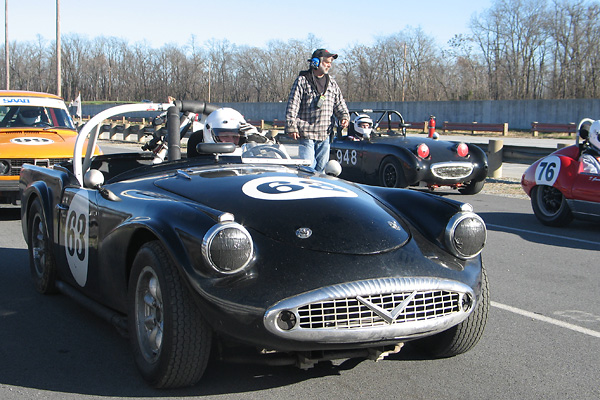
�
Joe Dockman's 1960 Daimler SP250 Race Car, Number 63
� ��
Owner: Joe Dockman
�
City: Baltimore MD
�
Model: 1960 Daimler SP250 (aka "Dart")
�
Engine: Daimler 2.5L V8
�
Restored and race prepared by: Robert Moser, and then Joe Dockman �
Joe Dockman's Daimler SP250
��
Joe Dockman owns Daimler SP250 serial number 100185, which was originally purchased new�
and raced (from 1960) by John Piggott. Its original color was Old English White.�
Piggott raced the Daimler frequently at Marlboro Motor Raceway in Maryland. He usually �
finished a strong and very respectable second place to another Daimler SP250; the �
one famously driven by Duncan Black to an SCCA national championship victory. �
In 1963 Piggott raced against an even more famous Daimler SP250 driver: Mark Donohue. �
�
Richard McClure of Rockville Maryland purchased the SP250 from John Piggott sometime�
in the mid-sixties. After completing SCCA drivers' school and then entering just one �
race, McClure's employer transferred him to Hawaii. The Daimler went into storage for �
a couple years, and ultimately was sold. �
�
Robert Storck of Falls Church, Virginia bought SP250 number 100185 from Richard McClure�
in 1969. His friend Robert Moser helped bring the car back into racing form, and �
then crewed through three racing seasons. The car was repainted Dodge "Plum Crazy" �
purple, and it raced as number 13.�
�
The car's next owner was Jack Shafer of New Brunswick, New Jersey. He took it to a �
professional race prep shop to be fixed up once again, but he never got to race it.�
�
Robert Moser bought the SP250 in 1972. Painted silver and rechristened number 63,�
the Daimler was enthusiastically raced by Robert Moser, who also did his own �
maintenance and race preparation. After a major accident at Summit Point Motorsports �
Park in 1974, Moser painted the Daimler black. He continued racing it through another�
two seasons, before a limited family budget obliged him to stop. For sixteen years �
the car wasn't raced. In about 1991, and the Moser family decided to dust off the�
SP250 and get back into racing. Eventually though, Robert and his sons Joe and Bob�
switched to a series of Acura and Honda racecars. (Most of them have also been �
christened number "63".) They've continued to be very, very successful with the �
Hondas in SCCA's Improved Touring classes over the last seventeen plus years. �
�
�
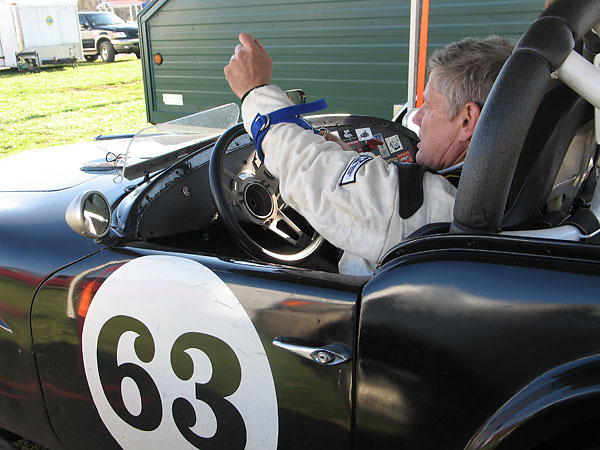
�
Joe Dockman prepares to race his Daimler SP250 at Summit Point Motorsports Park.
�
�
Joe Dockman used to be a frequent spectator at Marlboro Race Track back in the �
mid 1960's. Watching those SCCA races, he fell in love with the sound of Duncan �
Black's car. Joe couldn't afford the premium price of a Daimler back then, but �
he didn't forget the sound and the fury of the SP250's. He stopped following the �
SCCA racing scene when Marlboro closed in the early 1970's. Then, in the early �
1990's Joe discovered a "barn fine" SP250 near his home in Maryland. It was a �
former racecar from the 1960's that had previously been converted to street use. �
It still had the old roll hoop. As he restored it, Joe thought about racing but �
was concerned about the costs. Instead, he kept that SP250 as a street car, and �
sometimes drove it to attend vintage races. The racing bug took hold of him, �
and he began thinking about finding and building-up a second SP250 as a race car. �
When he contacted Robert Moser for advice on building an SP250 race car, he found �
Robert was extremely helpful. Then in one conversation Moser dropped the bomb. He �
said that his car could be for sale since he was now racing Hondas with his son. �
�
Joe Dockman purchased the number 63 Daimler from Robert Moser in February 2009.�
The car still has Bob's imprint on it in many ways. The only really significant �
change so far has been installation of the Kirkey aluminum racing seat. It fits �
Joe better, and it's an important safety upgrade too. Joe explains: "Safety is �
probably the most important thing to me, so that is what I will concentrate on."�
�
One thing that will definitely stay is the car's color. Black is a surprisingly rare �
color on vintage race cars, and Joe feels it suits his car perfectly. Then�
there's the marvelous rumble of the Daimler V8 engine. That's something that makes �
these cars very special.�
�
�
Enjoying this article? www.BritishRaceCar.com is partially funded through generous support from readers like you!
�
To contribute to our operating budget, please click here and follow the instructions.
�
(Suggested contribution is twenty bucks per year. Feel free to give more!)�
Notes about a couple rivals...
��
Duncan Black's SP250 was serial number 100033. The most successful of all SP250�
racecars, Duncan Black's car was purchased, converted for street use, and then retained �
within one family's ownership for over twentyfive years. Finally, in 2005, 100033 was �
purchased by an British car dealer and shipped back to England. Its current owner is �
John Abel, who purchased it in 2007. John has carefully and thoroughly documented 100033's �
provenance, and has had the car restored to replicate how it appeared and performed�
at the peak of Duncan Black's time with the car. �
�
Another successful racing SP250 belonged to Bill Jarrell. It qualified for and raced �
in the SCCA run-offs in 1973. Bill Jarrell's car was serial number 100163, and it raced �
in the Washington DC region as car number 64. Bill is deceased, and ownership of�
the SP250 has transferred to his son. �
�
 �
�
�
�
Features and Specifications
�| Engine: | �Daimler 2.5L Hemi, bored 0.040" over (2616cid).�
Custom Venolia forged pistons on stock connecting rods.�
Approximately 12:1 static compression ratio.�
Custom ground camshaft.�
Manley Performance valves. �
Stock dual S.U. HD6 (1.75" bore) carburetors with special modified jet needles. �
Stock Lucas distributor. Lucas sport coil.�
Accel Hi-Temp SuperStock 8mm spark plug wires. �
Pertronix digital rev limiter (set to 6000rpm). �
Barnes Systems external single-stage (wet sump) oil pump. �
An external oil line has been added to lubricate the cam and lifters more directly.�
Accusump oil accumulator.�
Mocal remote oil filter mount.�
Fram HP1 racing filter. | �
| Cooling: | �original radiator, modified.�
Spal electric cooling fan. | �
| Exhaust: | �custom 4-into-1 long primary headers flow into dual side pipes. | �
| Transmission: | �stock 4-speed.�
Tilton 7.25" dual stage clutch.�
Tilton flywheel. | �
| Rear End: | �Dana 44 (from a Sunbeam Tiger) with 3.92:1 gear ratio and Detroit Locker differential. | �
| Front Susp.: | �Triumph Competition coil springs with KONI adjustable shocks.�
One inch sway bar. | �
| Rear Susp.: | �semi-elliptic leaf springs with a Panhard bar and Pro-Shocks tubular shocks. | �
| Brakes: | �(master) dual Tilton master cylinders with bias bar. Tilton brake balance valve on the rear circuit. � (front) stock Girling disc brakes with 10" rotors and racing pads. � (rear) stock Girling disc brakes with 10" rotors and racing pads. | �
| Wheels/Tires: | �genuine Minilite magnesium racing wheels with Hoosier Vintage TD (15" x 5.50") tires. | �
| Electrical: | �stock Lucas generator and starter.�
Lead/acid battery. | �
| Instruments: | �(left to right)�
original Smiths mechanical tachometer (0-7000rpm),�
Stewart Warner coolant temperature gauge (100-260F),�
Stewart Warner engine oil pressure gauge (5-100psi),�
Stewart Warner oil temperature gauge (140-320F),�
Lucas ammeter (+/-30 amps). | �
| Fuel System: | �Fuel Safe Systems 8 gallon fuel cell.�
Facet fuel pump. | �
| Safety Eqmt: | �Kirkey aluminum racing seat.�
Impact Racing five point latch-and-link safety harness.�
Phoenix Fire Suppression System (5 pound Halon type, with bottle mounted in the boot.) | �
| Weight: | �at least 2040#, to comply with SVRA class requirements. | �
| Racing Class: | �due to changing rules this car has completed in SCCA's C, D, and E Production classes. | �
Engine Installation
��
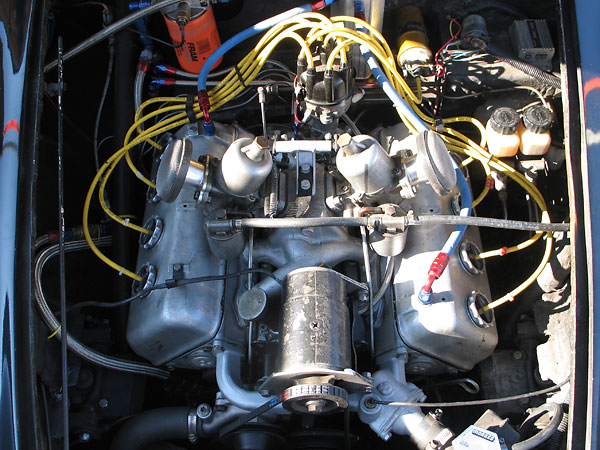
�
Ed Turner designed the Daimler engine. He was already famous for designing Triumph motorcycle engines.
�
The little hemi features an iron block topped with aluminum heads. Stock compression ratio was 8.2:1.
�
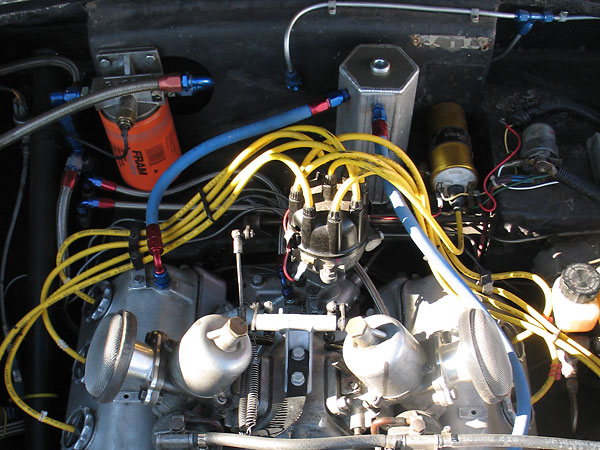
�
The 3.0" (76.2mm) bore by 2.75" (69.85mm) stroke yielded a 153 cubic inch (2548cc) displacement.
�
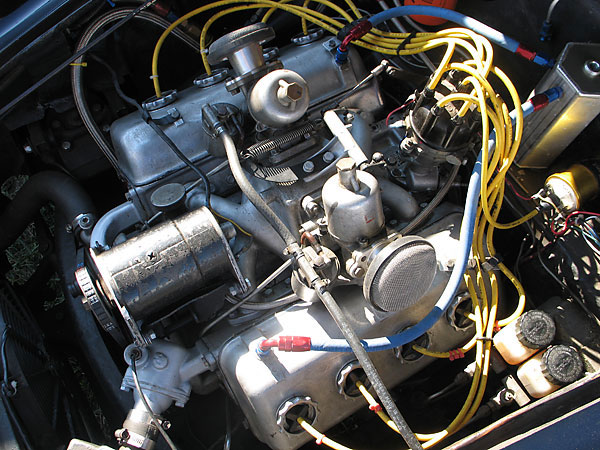
�
Notice the interesting coolant manifold and thermostat housing, underneath the Lucas generator.
�
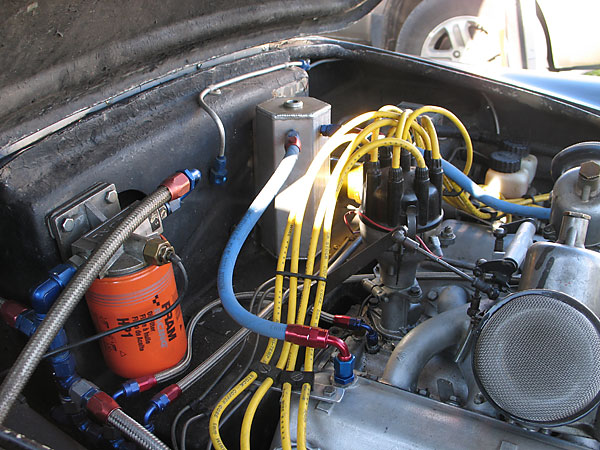
�
Mocal remote oil filter mount and Fram HP1 racing filter.
�
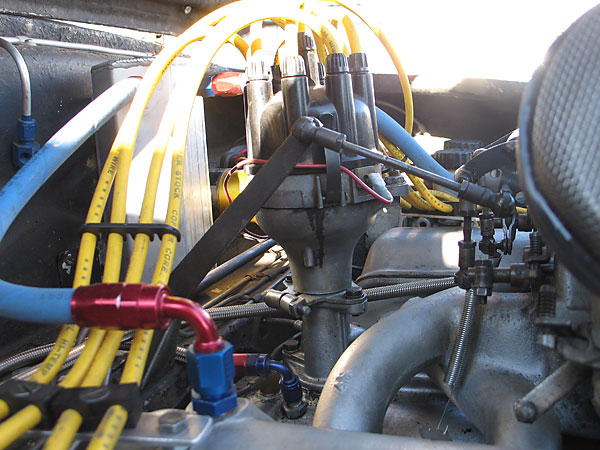
�
Stock Lucas distributor.
�
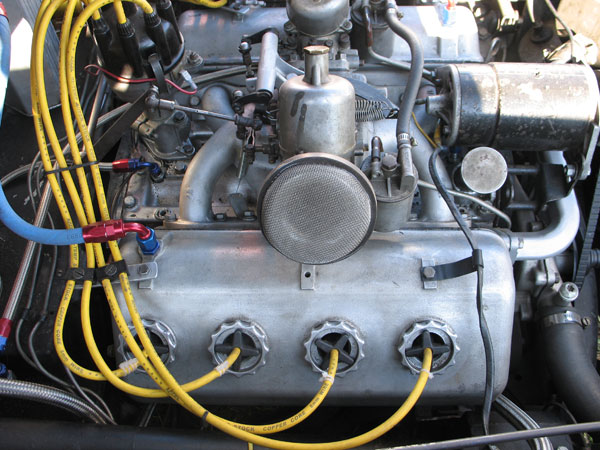
�
Stock dual HD6 (1.75" bore) S.U. carburetors with special modified jet needles.
�
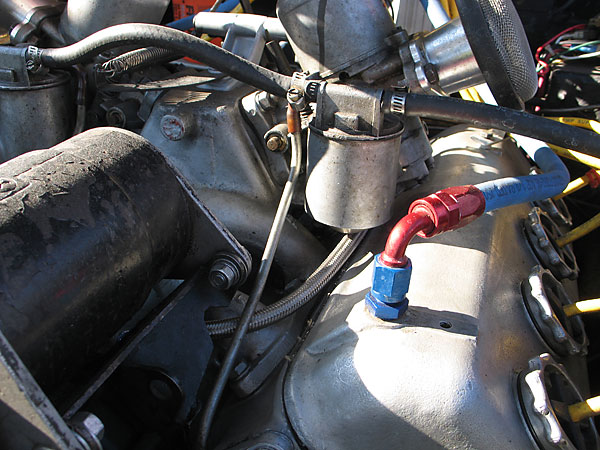
�
Notice the short and widely bell-mouthed velocity stacks.
�
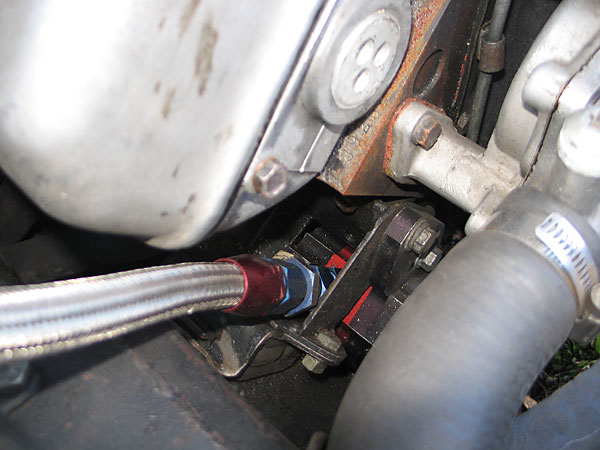
�
Barnes Systems external single-stage (wet sump) oil pump.
�
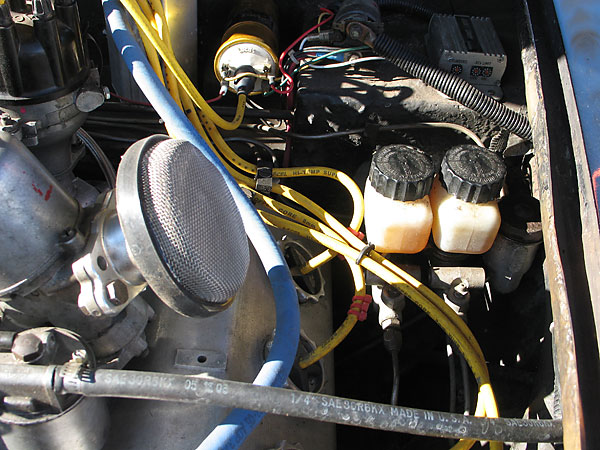
�
Dual Tilton brake master cylinders with bias bar. Girling clutch master cylinder.
�
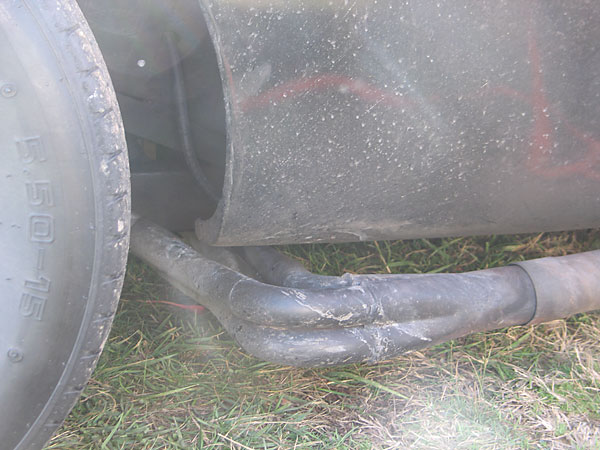
�
Custom 4-into-1 long primary headers flow into dual side pipes.
�
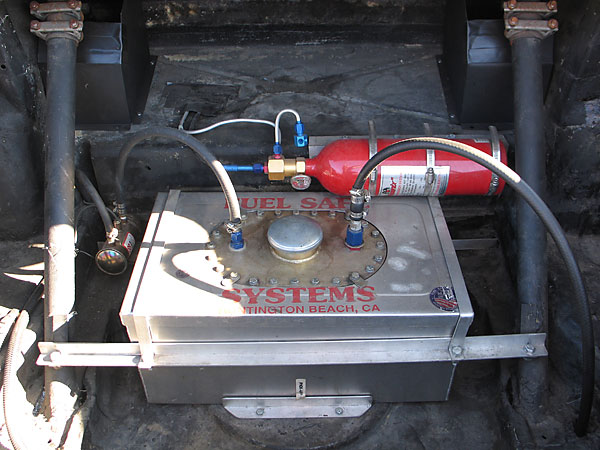
�
Fuel Safe Systems 8 gallon fuel cell. Facet fuel pump.
�
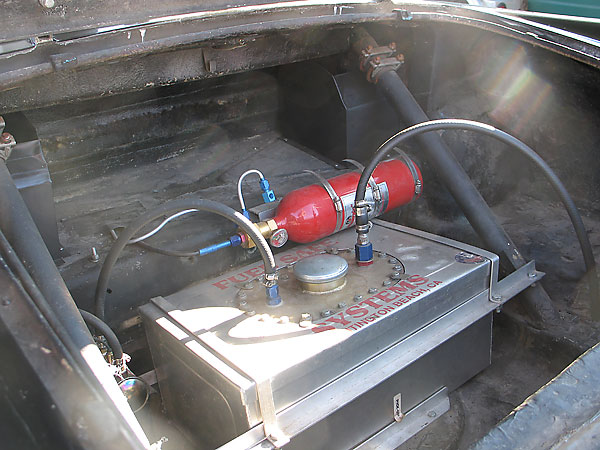
�
Phoenix Fire Suppression was a pioneer in offering Halon fire suppression systems for racing.
�
The company has now been sold to Stroud Safety, who offers a full line of safety equipment.
�
�
Front Suspension
��
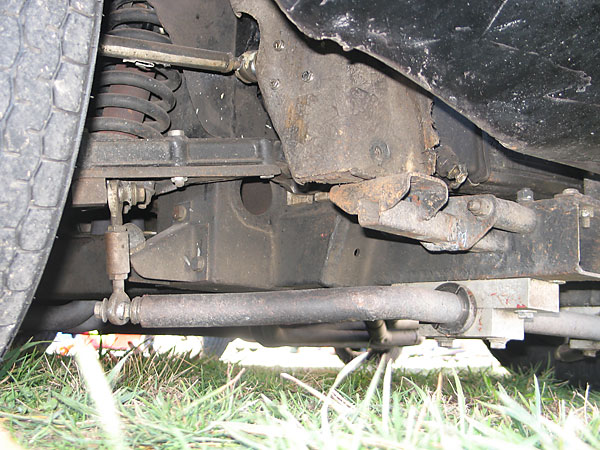
�
The frame front end was rebuilt with upgraded steel and crush tubes, and to support a 1 inch sway bar.
�
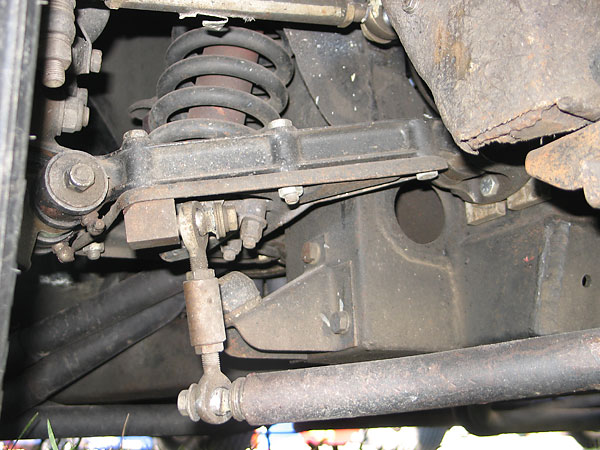
�
Triumph Competition coil springs with KONI adjustable shocks.
�
�
Interior
��
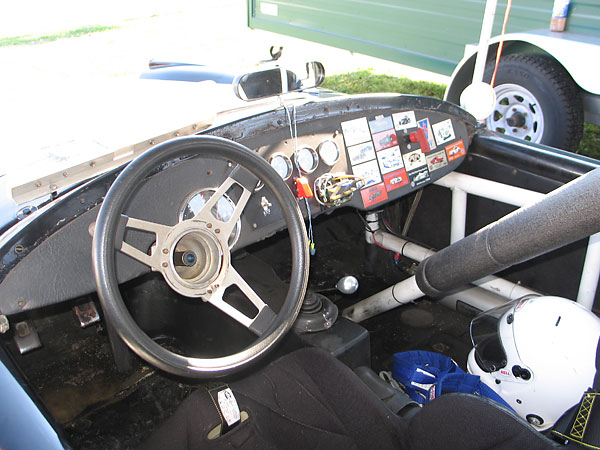
�
A "Petty bar" braces the main roll hoop, extending forward diagonally toward the passenger footwell.
�
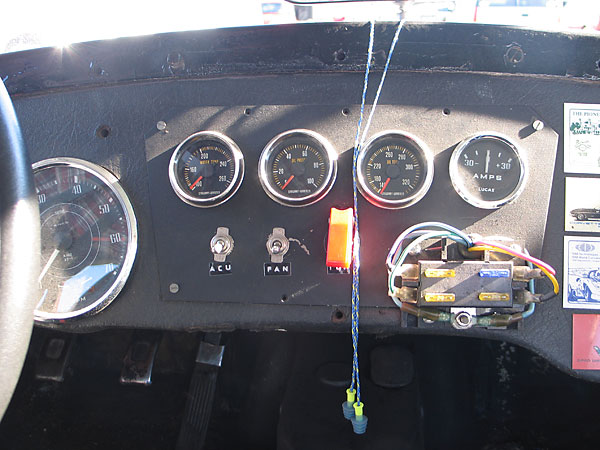
�
(left to right) Smiths mechanical tach (0-7000rpm), Stewart Warner coolant temperature gauge (100-260F),
�
engine oil pressure gauge (5-100psi), oil temperature gauge (140-320F), and Lucas ammeter (-30 to 30 amps).
�
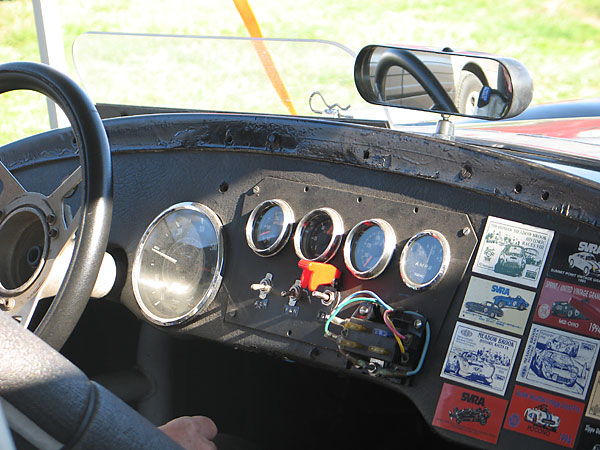
�
The three toggle switches are marked (left to right) "ACU", "FAN", and "IGN".
�
The ACU switch activitates a solenoid valve on the Accusump oil accumulator.
�
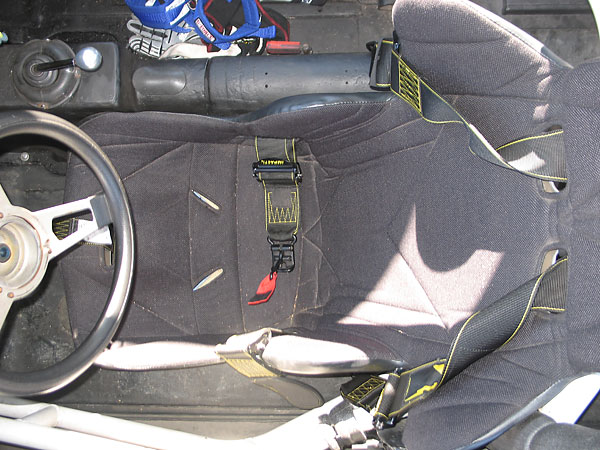
�
Kirkey aluminum racing seat, and Impact Racing five point latch-and-link safety harness.
�
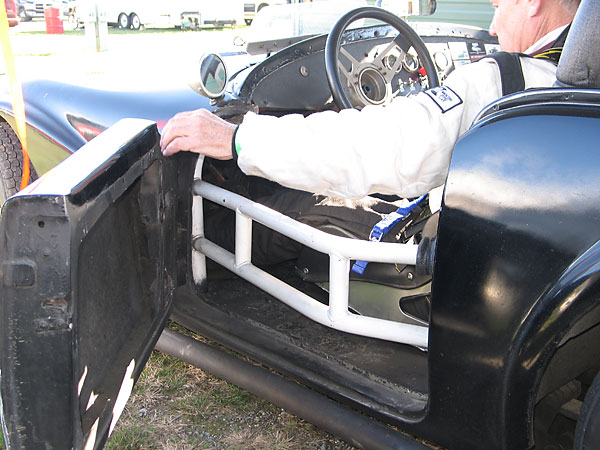
�
The roll cage features extra-strong protection from side intrusion.
�
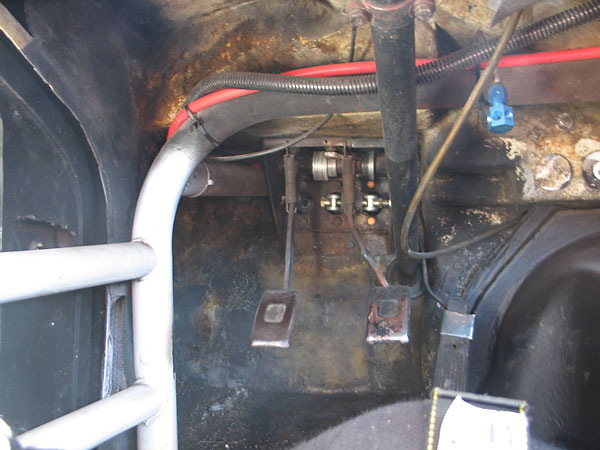
�
Note that the safety structure also extends forward through the firewall.
�
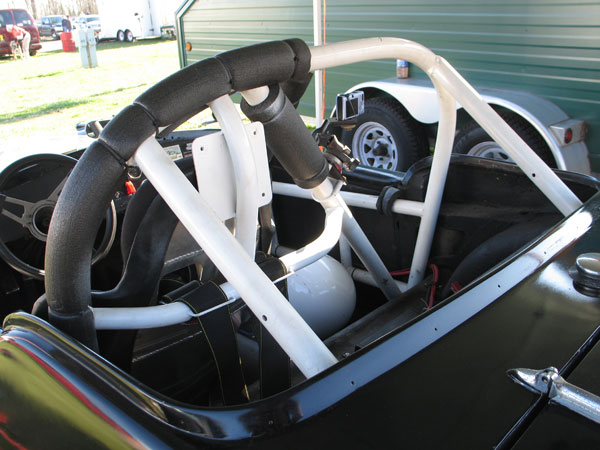
�
Quite large bend radii in the main roll hoop are a very nice - and very unusual - fabrication detail.
�
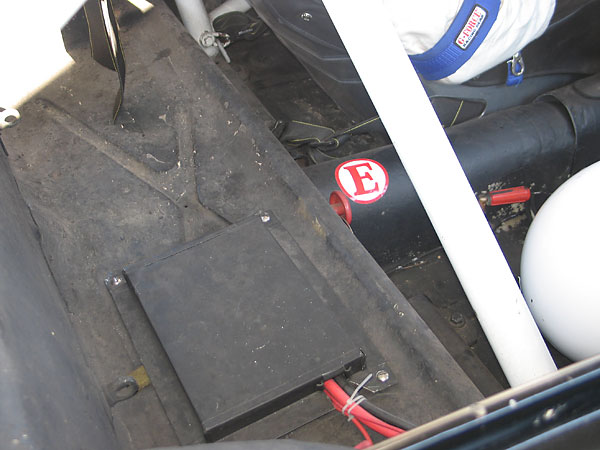
�
The battery is mounted under the rear shelf. Note also the Tilton brake balance valve on the driveshaft tunnel.
�
�
Exterior
��
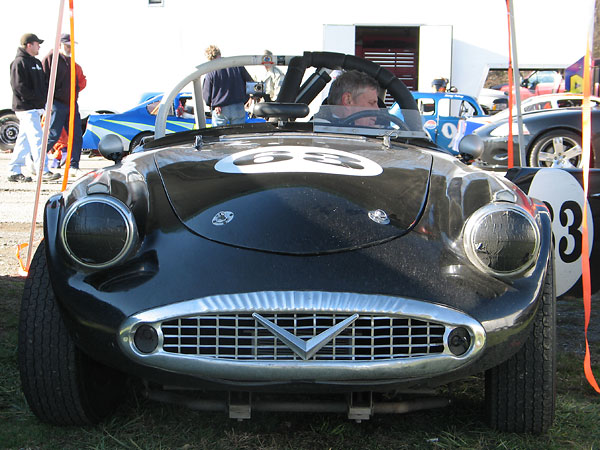
�
The crenulated top grille bar is a distinctive Daimler styling feature that dates back to 1923.
�
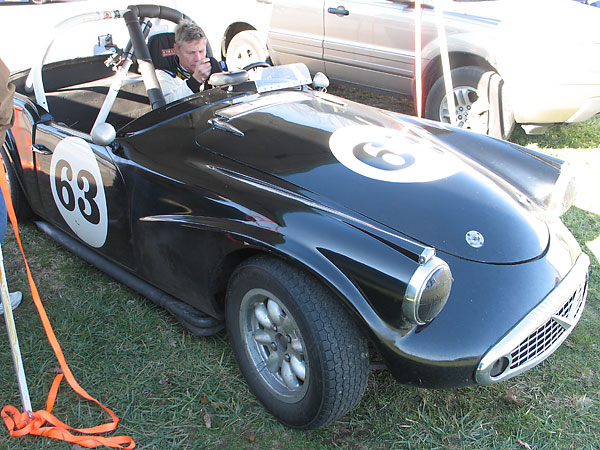
�
The Daimler SP250 was one of the first British street cars to come with an all-fiberglass body.
�
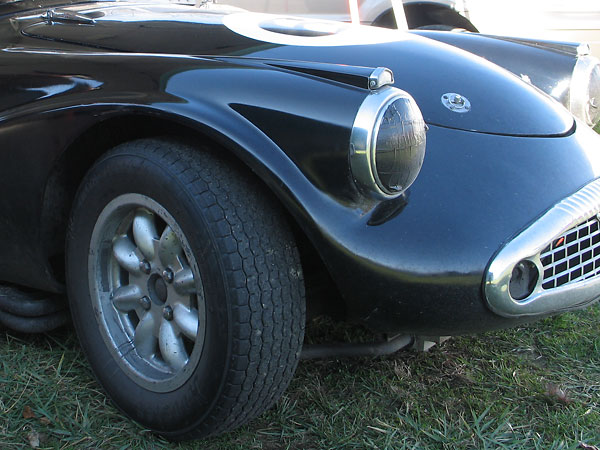
�
At the beginning of Daimler SP250 production, bumpers were considered "optional equipment".
�
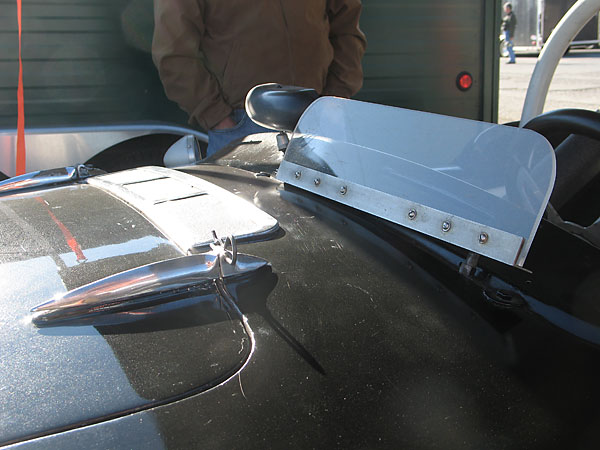
�
This compact perspex windscreen is a charming period modification.
�
Note also that special hingepins facilitate quick bonnet removal.
�
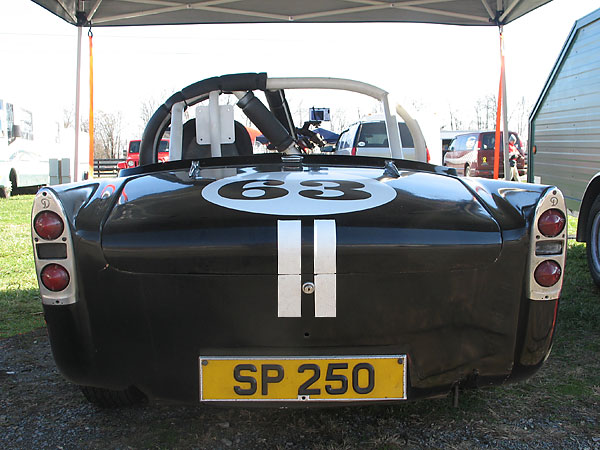
�
In the U.S. this model is called "SP250". Daimler was blocked from using the name "Dart" by Chrysler.
�
Mass production of the Dodge Dart started with Chrysler's 1960 model year.
�
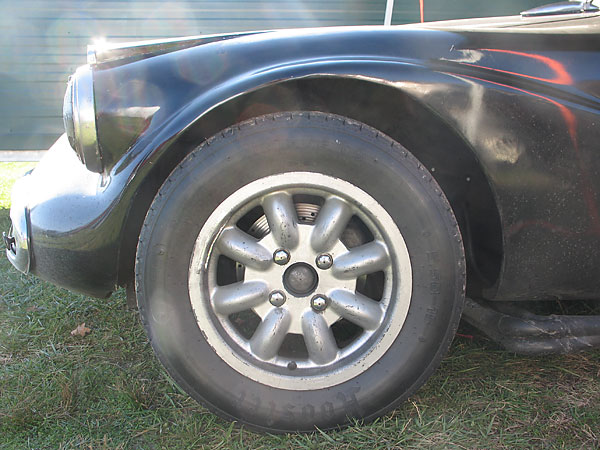
�
Genuine Minilite magnesium racing wheels.
�
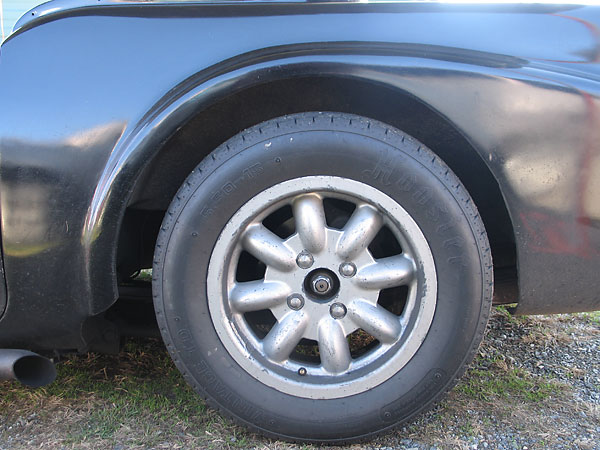
�
Hoosier Vintage TD 15"x5.50" tires.
�
�
All photos shown here are from November 2009 when we viewed the car at VRG's Turkey Bowl�
at Summit Point Motorsports Park, West Virginia. Photos by Curtis Jacobson for BritishRaceCar.com, �
copyright 2009. All rights reserved.
�
| If you liked this article, you'll probably also enjoy these: | �|||||
 | �
Duncan Black 1949 Lester MG | �
 | �
Mark Rosenberg 1959 Peerless GT | �
 | �
Larry Ligas 1961 Daimler SP250 | �
| You're invited to discuss anything you've seen here on The British Racecar Motorsports Forum! | �|||||
�
Notice: all the articles and almost all the photos on BritishRacecar.com are by Curtis Jacobson.
�
(Photos that aren't by Curtis are explicitly credited.) Reproduction without prior written permission is prohibited.
�
Contact us to purchase images or reproduction permission. Higher resolution images are optionally available.
�

 �
�